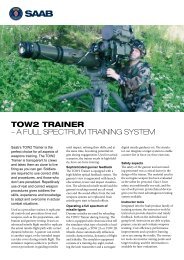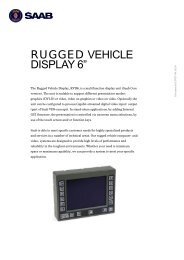acms airborne communications management system - Saab
acms airborne communications management system - Saab
acms airborne communications management system - Saab
You also want an ePaper? Increase the reach of your titles
YUMPU automatically turns print PDFs into web optimized ePapers that Google loves.
ACMS AIRBORNE<br />
COMMUNICATIONS<br />
MANAGEMENT SYSTEM
ACMS – Airborne CoMMuniCAtionS MAnAgeMent SySteM<br />
FOR ALL REQUIREMENTS IN<br />
ALL TYPES OF AIRCRAFT<br />
ACMS FUNCTIONAL FEATURES<br />
integrates peripheral equipment such as radios,<br />
radio navigation, audio equipment and gSM etc.<br />
Controls frequencies and operational modes<br />
of radios and radio navigation equipment.<br />
Provides the aircraft audio warning<br />
generator function.<br />
includes a programmable interCom<br />
System (iCS) capability.<br />
ACMS DESIGN FEATURES<br />
excellent speech intelligibility by use of digital audio.<br />
Powerful Digital Communications bus (DCb)<br />
structure for <strong>system</strong> scalability.<br />
open <strong>system</strong> architecture for fl exible and easy<br />
avionics integration.<br />
Modular and expandable hardware and software<br />
architecture to meet the complete range of<br />
communication <strong>management</strong>.<br />
Simplifi ed and reduced aircraft looms due to<br />
distributed DCb structure.<br />
Programmable Human-Machine interface (HMi)<br />
adaptable to user requirements.<br />
Direct sunlight readable and night Vision goggle<br />
(nVg) compatible displays.<br />
System set up through Aircraft Data Loader prior to<br />
mission for reduced operator workload.<br />
Multiple redundancy and back-up features.<br />
Secure communication compliant (teMPeSt).<br />
2
ACMS – Airborne CoMMuniCAtionS MAnAgeMent SySteM<br />
ACMS DESCRIPTION<br />
ACMS is a highly integrated, civil certifi ed and military qualifi ed Communications Management System. the ACMS<br />
features Audio Management (including intercom), radio Management and radio navigation equipment Management.<br />
it provides facilities for the generation, integration and <strong>management</strong> of aircraft audio warning signals, in the<br />
form of tones and voice messages. the ACMS can be confi gured for all communication <strong>management</strong> requirements<br />
in all types of aircraft, a fl exible and future proof solution.<br />
The ACMS is a very flexible control and<br />
display <strong>system</strong> for the <strong>management</strong> of<br />
aircraft <strong>communications</strong> and radio navigation<br />
equipment integrating digital audio<br />
and equipment control facilities. ACMS<br />
also features full intercom capability. The<br />
software programmable Human Machine<br />
Interface (HMI) allows for the customisation<br />
of <strong>system</strong>s for different users and<br />
aircraft. The open architecture of the ACMS<br />
allows integration of any customer selected<br />
radio and radio navigation equipment. The<br />
ACMS can be regarded as a sub-element of<br />
the core avionics of an aircraft. The ACMS<br />
can be scaled. Functions in the <strong>system</strong> are<br />
under software control and therefore the<br />
ACMS can satisfy the <strong>communications</strong><br />
requirements of any aircraft type, e.g. heli-<br />
copters, fighters, light and heavy transport<br />
aircraft, etc.<br />
The ACMS can be configured to provide<br />
secure <strong>communications</strong> capabilities by<br />
fulfilling requirements for compromising<br />
emanation (TEMPEST compliant) and<br />
separation of secure and general (red and<br />
black) communication.<br />
Three building blocks are available, namely<br />
the General Control Panel (GCP), the Remote<br />
Control Panel (RCP) and the General<br />
Interface Unit (GIU). These building blocks<br />
are interconnected by means of a 2 Mb/s<br />
dual redundant Digital Communications<br />
Bus (DCB) in a token ring configuration.<br />
Systems may be configured using only one<br />
building block, i.e. the GCP, or all three in a<br />
comprehensive solution.<br />
The ACMS can be integrated with an aircraft<br />
avionics <strong>system</strong> via standard interfaces.<br />
This feature allows for further automation<br />
and therefore reducing pilot workload.<br />
The capability to control the radios and<br />
radio navigation equipment from a Multifunction<br />
Central Display Unit (MCDU) via<br />
the ACMS is available.<br />
The ACMS can be programmed with radio<br />
channel databases (Complans) prior to a<br />
mission. ACMS health status data, including<br />
health status data of the peripheral<br />
equipment connected to it, can be extracted<br />
from the ACMS after a mission by an Aircraft<br />
Data Loader (ADL).<br />
3
ACMS – Airborne CoMMuniCAtionS MAnAgeMent SySteM<br />
ACMS BUILDING BLOCKS<br />
GENERAL CONTROL PANEL (GCP)<br />
The GCP provides the operator interface<br />
for both audio <strong>management</strong> and peripheral<br />
equipment control and includes:<br />
• Five software definable rotary switches<br />
with pushbuttons and a graphics LCD<br />
display.<br />
• Microphone and headset audio interfaces<br />
with audio controls.<br />
• HMI menus and status display for<br />
<strong>communications</strong> <strong>management</strong> (i.e.<br />
setting up frequencies and modes of<br />
the radios and radio navigation equipment).<br />
A secondary function of the GCP is to act<br />
as a backup controller for peripheral equipment<br />
such as radios and radio navigation<br />
equipment. The GCP may be connected<br />
to a Multifunction Central Display Unit<br />
(MCDU) to enhance the HMI capability of<br />
the cockpit.<br />
4<br />
gCP FeAtureS<br />
• Voice operated intercom operation (VoX).<br />
• Alarm tone/Message generators/playback.<br />
• Audio Digitizing, Mixing, Switching and<br />
routing.<br />
• radio and radio navigation equipment<br />
Control (frequencies and modes, as well as<br />
Ptt control and <strong>management</strong> for radios).<br />
REMOTE CONTROL PANEL (RCP)<br />
The RCP provides the Operator Interface<br />
for audio <strong>management</strong>, headset interfaces<br />
and radio PTT interfaces. A smaller unit<br />
with less equipment interfaces compared<br />
with the GCP. The operator interface<br />
includes:<br />
• Five software definable rotary switches<br />
with pushbuttons and a graphics LCD<br />
display.<br />
• Microphone and headset audio interfaces<br />
with audio controls.<br />
• HMI menus and status display for<br />
Communications Management.<br />
A secondary function of the RCP is to provide<br />
<strong>communications</strong> control <strong>management</strong><br />
capabilities (i.e. radio control, radio navigation<br />
control, PTT <strong>management</strong>, and warning<br />
tones/messages playback) via the DCB.<br />
The RCP is smaller than a GCP (reduced<br />
unit depth) and can be installed in areas<br />
where limited space is available. It is suitable<br />
for use by the pilots in a cockpit due to<br />
the fact that all <strong>communications</strong> functions<br />
controllable from a GCP can be controlled<br />
from an RCP (via the DCB) as well.<br />
rCP FeAtureS<br />
• Voice operated intercom operation (VoX).<br />
• Alarm tone/Message generators/playback.<br />
• Audio Digitizing, Mixing, Switching and<br />
routing.<br />
• radio and radio navigation equipment<br />
Control via the DCb (frequencies and modes,<br />
as well as Ptt control and <strong>management</strong><br />
for radios etc.).<br />
GENERAL INTERFACE UNIT (GIU)<br />
The GIU interconnects peripheral <strong>communications</strong><br />
equipment and provides<br />
integrated <strong>communications</strong> <strong>management</strong><br />
capabilities without any operator interface.<br />
The GIU can be connected to Radios, Air<br />
Traffic Control Transponders (ATC or IFF),<br />
Aircraft Information Systems (AIS), Sonar<br />
Buoy Systems, Global System for Mobile<br />
<strong>communications</strong> (GSM) and Radio Navigation<br />
equipment such as<br />
VOR/ILS, DME, ADF etc. The GIU also<br />
provides data bus connections to aircraft<br />
data busses for avionics <strong>system</strong> integration<br />
purposes. (ARINC 429 Busses and/or MIL-<br />
STD-1553B Busses).<br />
The GIU is basically a GCP without a bezel.<br />
It is installed in the equipment bays of<br />
aircraft, close to the peripheral equipment,<br />
to reduce loom length and weight.<br />
giu FeAtureS<br />
• Alarm tone/Message generators/playback.<br />
• Audio Digitizing, Mixing, Switching and<br />
routing.<br />
• Microphone and headset audio interfaces<br />
with audio controls.<br />
• radio and radio navigation equipment<br />
Control (frequencies and modes, as well as<br />
Ptt control and <strong>management</strong> for radios).<br />
• Voice operated intercom operation (VoX).
ACMS – Airborne CoMMuniCAtionS MAnAgeMent SySteM<br />
ACMS HUMAN-MACHINE INTERFACE<br />
The ACMS can be operated from a Multifunction<br />
Central Display Unit, (MCDU). In<br />
the event that the MCDU display is selected<br />
for another sub<strong>system</strong> HMI, the GCPs can<br />
be used to operate the complete <strong>communications</strong><br />
and radio navigation <strong>system</strong>. From<br />
the GCPs, the audio as well as the radio and<br />
radio navigation equipment control can be<br />
performed (setting up frequencies, modes,<br />
etc.). In normal operating mode of the<br />
ACMS, the MCDUs are used as the radio<br />
and navigation equipment control and<br />
display HMI and the GCPs are primarily<br />
used for the audio control and display HMI.<br />
Should the MCDU fail, the GCPs are used<br />
to provide the full HMI (audio and equipment<br />
control) for the ACMS in a back-up<br />
mode of operation.<br />
Depending on the type of aircraft a Radio<br />
Selection Device (RSD) could for example<br />
be mounted on the control stick as a fourway<br />
switch. The radios can be selected by<br />
moving the RSD switch up or down. The<br />
selected radio is indicated on the MCDU<br />
and GCP/RCP displays. By moving the<br />
RSD sideways, the pre-programmed radio<br />
channels (programmed into the ACMS<br />
using the Aircraft Data Loader prior to a<br />
mission) can be selected. The ACMS then<br />
sets up the selected radio to the selected<br />
channel (frequency, mode, etc.). The RSD<br />
thus allows for HOCAS/HOTAS and<br />
simplifies the operation of the <strong>system</strong>. The<br />
radio navigation equipment can be set-up<br />
automatically from an external navigation<br />
computer via the external serial interfaces<br />
to the ACMS (Auto-tune). The GCP/RCPs<br />
also have a programmable master volume<br />
control to simplify handling.<br />
If a mission deviates from the initial plan,<br />
the ACMS can be fully operated from the<br />
MCDUs and/or the GCPs/RCPs.<br />
EXAMPLES OF ACMS HMI DISPLAYS<br />
MCDU<br />
radio Management<br />
System Main HMi Page<br />
GCP/RCP<br />
monochrome version<br />
radio Frequency<br />
Control Page<br />
GCP/RCP<br />
monochrome version<br />
radio navigation Audio<br />
Volume Control<br />
GCP/RCP<br />
colour version<br />
(option)<br />
5
ACMS – Airborne CoMMuniCAtionS MAnAgeMent SySteM<br />
TYPICAL ACMS ARCHITECTURES<br />
SMALL SYSTEM WITH DUAL REDUNDANCY<br />
LUH SYSTEM WITH GCPs, RCPs AND GIUs<br />
A - Audio, C - Control, D - Discretes, e - erase, P - Ptt, AWDs - Aircraft Warning Discretes, eLC - external Lighting Control, Ptt - Press to talk, rSD - radio Selection Device<br />
6
ACMS – <strong>airborne</strong> <strong>communications</strong> <strong>management</strong> <strong>system</strong><br />
ACMS SPECIFICATIONS<br />
GCP Specifications<br />
ARINC 429 Interfaces<br />
4 Transmit and 4 Receive ports<br />
RS485<br />
4 bi-directional ports<br />
RS422<br />
2 bi-directional ports<br />
Audio Interfaces<br />
8 input and 8 output ports<br />
Discrete Interfaces<br />
32 programmable bi-directional ports<br />
DCB Interface<br />
Dual Redundant Bus (2.048 Mb/s – based on ITU G703/4)<br />
MIL-STD-1553B Bus<br />
Bus Controller or Remote Terminal<br />
Analogue Interfaces<br />
Four 16 bit analogue-to-digital ports<br />
Display<br />
192 x 64 pixel monochrome graphics display<br />
NVG Compatibility<br />
MIL-STD-3009<br />
Power Consumption<br />
25 W at 28 VDC<br />
Mass<br />
1.9 Kg<br />
Size<br />
85 mm x 146 mm x 170 mm<br />
Operating Temperature: -40 °C to +70 °C<br />
RCP Specifications<br />
Audio Interfaces<br />
4 input and 4 output ports<br />
Discrete Interfaces<br />
8 programmable bi-directional ports<br />
DCB Interface<br />
Dual Redundant Bus (2.048 Mb/s, ITU G703/4)<br />
Analogue Interfaces<br />
Two 16 bit analogue-to-digital ports<br />
Display<br />
192 x 64 pixel monochrome graphics display<br />
NVG Compatibility<br />
MIL-STD-3009<br />
Power Consumption<br />
20 W at 28 VDC<br />
Mass<br />
1.5 Kg<br />
Size<br />
85 mm x 146 mm x 100 mm<br />
Operating Temperature -40 °C to +70 °C<br />
GIU Specifications<br />
ARINC 429 Interfaces<br />
4 Transmit and 4 Receive ports<br />
RS485<br />
4 bi-directional ports<br />
RS422<br />
2 bi-directional ports<br />
Audio Interfaces<br />
8 input and 8 output ports<br />
Discrete Interfaces<br />
32 programmable bi-directional ports<br />
DCB Interface<br />
Dual Redundant Bus (2.048 Mb/s - ITU G703/4)<br />
MIL-STD-1553B Bus Bus Controller or Remote Terminal<br />
Analogue Interfaces<br />
Four 16 bit analogue-to-digital, ports<br />
Power Consumption<br />
20 W at 28 VDC<br />
Mass<br />
1.5 Kg<br />
Size<br />
85 mm x 146 mm x 160 mm<br />
Operating Temperature: -40 °C to +70 °C<br />
Qualification Standards<br />
Qualification<br />
MIL-STD-810E, MIL-STD-461E, RTCA DO-160E, RTCA/DO-178B
www.saabgroup.com<br />
Doc. id: B-300009 - Eng. - Ver 1. - October 2009



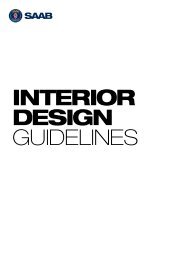
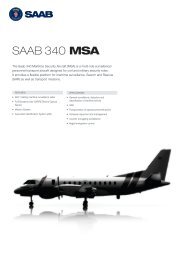
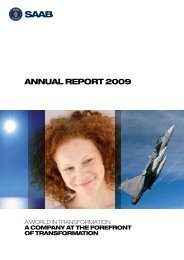
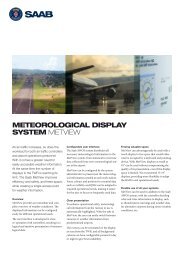
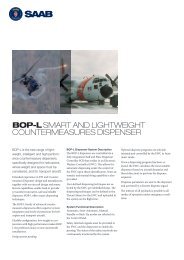



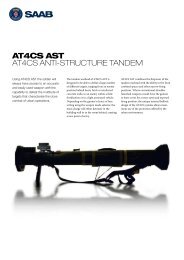


![Proposal long-term incentive programs [pdf] - Saab](https://img.yumpu.com/50411723/1/190x245/proposal-long-term-incentive-programs-pdf-saab.jpg?quality=85)

